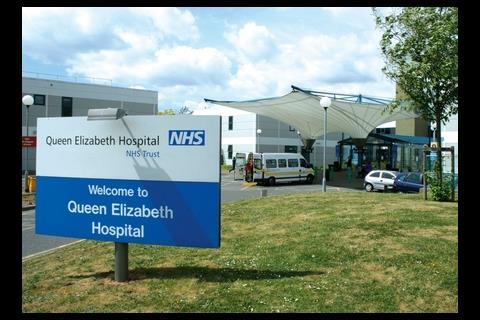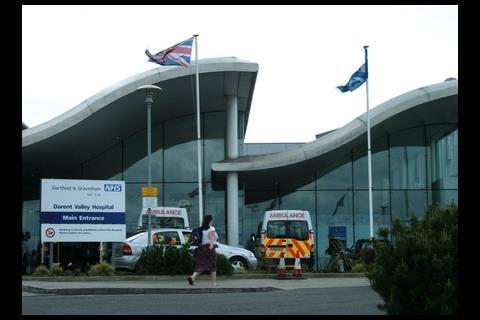Some PFI consortiums have won leases on their hospital that run for almost a century after they finish their contract. Mark Leftly reveals the Department of Health’s risky gamble
The Department of Health (DoH) has gambled an extraordinary half-billion pounds of publicly owned assets and land. Building can reveal that five PFI hospital schemes signed in the late nineties may give the private sector partners ownership of the sites up to 95 years after the contract completes.
The government has defended claims that PFI amounts to privatisation by pointing out that all land and assets will return to the public sector on termination of the PFI contract. In these five schemes, that is not necessarily the case. Potentially, the consortium could have decades to develop the land as it would still have a lease
past the end of the PFI deal. Although the assets would eventually return to the public sector, in the years in between the NHS trust could lose its right of access and the hospital may be forced to close.
There were a variety of reasons why the DoH would risk losing control of its land, but two are particularly striking: a desperate need to attract companies to bid for and then sign PFI projects; and to help ensure that the project did not go on the government’s balance sheet, so it could claim not to have spent any money despite commissioning the shiny new hospitals.
The request
A news story in Building last year revealed that the £2bn Colchester Garrison project gives ownership of Ministry of Defence (MoD) land to the Sir Robert McAlpine-led RMPA consortium for 115 years after the contract ends. One critic accused the MoD of “selling the family silver”.
Following this, Building made a freedom of information request to the MoD, the DoH and the Department for Education & Skills (DfES) asking how many of their PFI and PPP schemes had leases that exceeded the contract length.
Incredibly, Defence Estates, the MoD’s property arm, said the information was not held centrally and would cost more than £600 to collate – over the limit at which bodies are obliged to adhere to a request. The DfES said that no such instances exist.
The DoH said five out of the 43 large deals it has signed to date have leases, which confers ownership of the hospitals’ land and assets, that go beyond the length of the PFI contract. These five hospitals are:
- The £93m Queen Elizabeth hospital in Greenwich, south-east London
- The £177m Darent Valley scheme in Dartford, Kent
- The £87m Cumberland Infirmary in Carlisle
- The £64m Hereford County hospital
- The £96m University hospital in Durham.
The DoH argues that the extended leases will have no adverse consequences and that trusts retain the freehold. “In all cases, the trust can exercise an option to terminate the lease in its favour on expiry of the contract,” it said. Upon further enquiry, a senior source at the DoH accused Building of “just looking for a story”, and Peter Coates, the ministry’s director of finance investment, said: “Termination is at terms set by the trust.”
The real deal at Greenwich
The reactions of senior sources at the trusts, most of whom were not involved in the original deals, indicate that there is more to the story. “I don’t understand why they’ve done it,” was one response. “I’m trying to understand myself why the lease term would go on beyond the service contact.”
It transpired that there were good reasons for each of the trusts to sign its deal, although the circumstances differed. At the Queen Elizabeth hospital, a 125-year lease was inserted to assure the private sector partner, a consortium that had Kvaerner (now Skanska) as contractor and Innisfree as financer, that the trust would take on the PFI for the whole contract.
Although the PFI deal is generally reported to have a 30-year term, it in fact goes on for 60. As Coates points out, at the close of the 60-year contract, the trust can take the land and hospital back to sell or continue to use for healthcare.
The reason why it is generally thought of as a 30-year scheme is because this marks the end of the first PFI period. At this point, the trust can agree to go into a second PFI period, where its £13m a year fee “goes through the floor” to about £2m, according to a source close to the trust. This is because the PFI partner’s own costs will go down after it pays back its funding.
Essentially, a break clause occurs at year 30 and then again at year 45. If the trust walks away from the deal at those points – for example, because there is sufficient healthcare provision in the area or the trust turns against PFI policy – then Skanska and Innisfree will have the assets and land until the next century to develop as it wishes, provided it has planning permission.
David Wragg, the trust’s director of finance, says: “If the trust quits the deal after 30 years, the PFI company has the head lease for a further 95 years, until 2126.”
The deal was signed before Wragg took up his post, so he was not party to the negotiations that led to its insertion. He says: “I presume the 125-year head lease, which occurs only if the trust terminates at 30 or 45 years, is to protect the PFI company from having no income from the deal from year 31 or year 46 onwards. If the protection had not been granted, the deal would have been more expensive for the NHS. The contract does not automatically allow us to buy out the head lease, nor give a price for doing so.”
I don’t understand why they’ve done it. I’m trying to understand why the lease term would go on beyond the service contract
Source at NHS trust
Wragg points out that the “likeliest scenario” is that the trust will stay in the deal and the extended lease means that the consortium charges a lower fee. But if the trust wants out prematurely, it will either have to give up the land, and access to the hospital, or buy out the private sector’s lease.
“We do look at it as a 60-year deal with expensive walk-away options at 30 and 45 years,” says a trust source. Or, to put it another way, the DoH is gambling that the trust will still need the PFI after 30 years. This has angered critics. Allyson Pollock,
the professor of public health policy at the University of Edinburgh and a prominent critic of the PFI, says: “This raises big questions. The government told us that all land and buildings would revert to the public sector at the end of the contract. What we now need to understand is whether this is indeed the case. What are the extra payments for the public? What is it paying for?”
A senior PFI lawyer says the trust would have to pay up if it wanted the land back. The lawyer, who was party to some of the deals, adds: “The leases sweetened the deals, helping to get bidders on board. Also, they showed that the private sector had some real interest in the project, which facilitated off-balance sheet treatment.” In other words, it looked like the assets and land belonged to the private sector – meaning the DoH would not have to put the hospital costs on its books.
The rest
In the case of the Darent Valley hospital, there is a 15-year difference between the 60-year contract expiry date and the 75-year lease. In a statement, Paul Traynor, the director of finance at Dartford and Gravesham, the NHS trust responsible for the hospital, says this is to protect against disaster. For example, if a fire destroys the hospital and it takes five years to rebuild, the lease covers the extra time.
Traynor says: “The lease and concession agreement have different allowable terms to allow for any suspension in services if the hospital becomes unusable. Otherwise, the lease and the concession agreement each terminate at the same time.”
However, an internet search shows that the minimum contract length is 35 years – it was increased from 28 years after a refinancing deal in 2003. Again, this is a break point in the contract and means that the private sector consortium, the Hospital Company (Dartford), can serve out its lease if the trust walks away from the deal at this point.
The Carlisle scheme has a lease that runs 80 years past contract expiry. It transpires that most of the site reverts back to the trust at the end of the PFI but this longer lease refers to a single redundant tower block that is considered particularly costly.
According to a senior source involved in the scheme, Treasury advice at the time was that giving the private sector a longer lease on this element would help take the scheme off the government’s balance sheet. Whether or not handing over public assets to balance the books is a responsible move is debatable.
The Hereford scheme has the most bizarre explanation. The DoH’s Coates says: “On expiry of contract, options include: remain at facilities and terminate lease and all licences cease; remain at facilities and extend agreement, leaving lease arrangements in place; remain at facilities and re-tender.”
Note the word “include”. There is another option – give the land to Mercia Healthcare, the PFI consortium. Kieran Lappin, the former director of finance at the trust, says: “We put in the 125-year lease so that in the unlikely event that there was negative value in the land we could just walk away.”
So, if the site were heavily polluted, Mercia Healthcare could deal with the problem. In essence, risk is passed on to the private sector. Arguably, this is a prudent move, but it is also odd for the trust to suggest giving up land ultimately funded by the public.
The North Durham deal seems to lack any real problems. As with the Darent deal, the 15 additional years on the lease is to cover any rebuilding that may be required. Unlike Darent, there is no break clause, so there seems to be no chance that the land and assets will remain with the private sector.
A spokesperson for Consort Healthcare, the Balfour Beatty-led consortium in the scheme, says: “At that time it was considered that the lease needed to have a longer period than the project agreement in order to allow for extensions of time under the agreement, for circumstances defined in the contract. However, the lease terminates at the same time as the project agreement.”
This scheme, then, seems to have sound reasoning. But the DoH recognised the potential for problems in allowing these differences, hence the introduction of coterminous lease and PFI contracts in 1999. By 2003, consortiums were allowed access to the land by licence rather than ownership.
The DoH has tried to play this down, but clearly the government recognises just how damaging this granting of long leases could be and then acted. This is not the fault of the private sector: it was the DoH’s gamble.
And a gamble is only a gamble if there is something to lose.
Queen Elizabeth
The leases showed that the private sector had some real interest in the project, which facilitated off-balance
sheet treatmentPFI lawyer
Scheme: £93m hospital in Greenwich, south-east London
Consortium: Skanska (then Kavaerner) and Innisfree.
PFI contract length: 60 years
Private sector’s lease: 125 years
If the NHS trust decides to take advantage of break points that fall on years 30 and 45, ownership of the land would be with the private sector until 2126.
Any previous controversies at this hospital? Yes. £9m of the trust’s £19m debt at the start of 2006 was estimated to have been caused by the burden of the PFI payments.
Cumberland infirmary
Scheme: £87m hospital in Carlisle
Consortium: Building & Property Group and Amec. The contract reached financial close in November 1997
PFI contract length: 45 years
Private sector’s lease: 125 years
The long lease refers to one abandoned tower on the site. Transferring ownership to the private sector shifted risk and helped the government get this scheme off its balance sheet.
Any previous controversies? Yes. In 2001 it was claimed that the hospital had cramped wards and sewage oozing out of theatre sinks.
Darent Valley
Scheme: £177m Darent Valley hospital in Dartford, Kent
Consortium: The Hospital Company (Dartford), then led by contractor Tarmac, later Carillion, reached financial close in July 1997
PFI contract length: 60 years
Private sector’s lease: 75 years
If the NHS trust walks away from the PFI deal after 35 years, land ownership would stay with the private sector for the next 40 years.
Any previous controversies? Yes. Carillion made £12m profit when it sold its equity stake in 2003 – critics argued PFI only benefited private sector.
Hereford county
Scheme: £64m Hereford County hospital
Consortium: Mercia Healthcare
PFI contract length: 30 years
Private sector’s lease: 125 years
The difference in the length of the lease and the PFI contract is more an oddity than a controversy. The public sector can give up the land to the private sector at the end of the PFI if it is of “negative value” – for example, if the site is polluted.
Any previous controversies? Not really, although Alfred McAlpine and Atkins sold their stakes in Mercia Healthcare for profits of £2.9m apiece.
Durham hospital
Scheme: £96m University Hospital of North Durham
Consortium: Consort Healthcare (Balfour Beatty)
PFI contract length: 30 years
Private sector’s lease: 45 years
This 15 year difference is not controversial. The difference is there so that a serious incident such as a fire can be more easily accommodated within the lease.
Any previous controversies? Yes. Ten people were taken ill owing to a salmonella outbreak in the hospital’s canteen three years ago.
Postscript
Comment on this story at www.building.co.uk/whatyouthink
































No comments yet